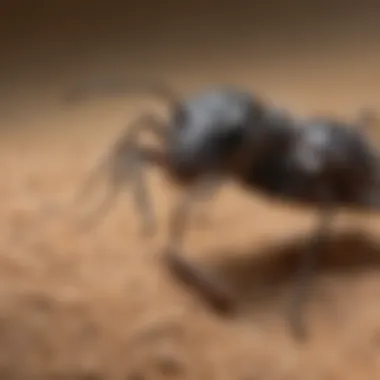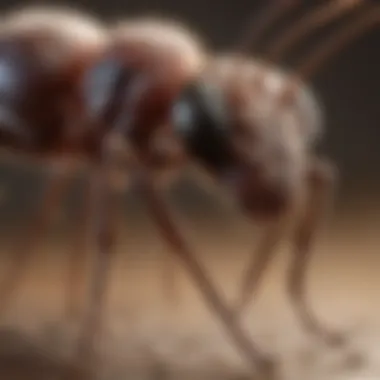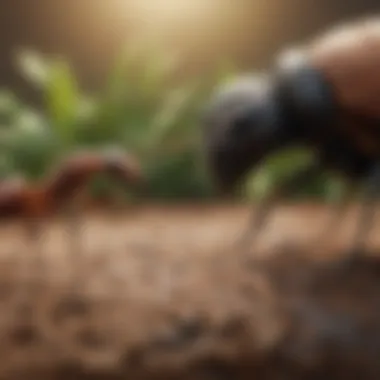Indoor Ant Control: Effective Management Strategies


Preventive Pest Control Strategies
Keeping indoor ants at bay starts with proper preventive measures. As the saying goes, "an ounce of prevention is worth a pound of cure." By establishing a robust barrier around your place, you can significantly reduce the likelihood of an ant infestation. Let’s dive into some critical preventative pest control strategies that you can implement to protect your indoor sanctuary.
House Exterior Protection
Tips for Sealing Cracks
First things first, it's essential to check the exterior of your house for cracks and crevices. These are like open invitations for ants to invade your space. Use caulk or weather stripping to seal gaps around windows, doors, and any other entry points. Think of it as putting a lid on a jar – you want to keep the contents inside, not let them spill out!
Clearing Debris
Make sure to clear away any debris near your foundation. Fallen leaves, wood piles, or even garden clippings can act as homes for ants and other pests. Keep a clean perimeter around your house; it’s like giving pests no place to hide.
Preventing Pests from Entering
Consider applying a barrier treatment to your foundation. Products like boric acid can deter the little critters. Think of it as creating a no-fly zone for ants. Just remember to follow safety guidelines closely when using these substances.
Yard Maintenance
Essential Yard Care Routines
A well-maintained yard is less likely to attract unwanted insects. Keeping grass trimmed and flower beds tidy can make a real difference. Regularly schedule yard care routines; it’s not just about aesthetic appeal – it’s about pest prevention too.
Methods for Keeping Yard Pest-Free
Utilize companion planting. Certain plants can repel ants and other garden pests. For example, planting mint or marigolds can deter ants while adding a pop of color to your garden. Just imagine, a beautiful yard and fewer pests to worry about!
Indoor Cleanliness
Expert Cleaning Tips and Techniques
A tidy house is less enticing for ants. Sweeping floors often, immediately wiping up spills, and keeping food tightly sealed can help maintain a pest-resistant indoor sanctuary. Regularly vacuum carpets and rugs to make sure there aren't any crumbs lying around.
Maintaining a Pest-Resistant Indoor Environment
Consider using air-tight containers for pantry items. It’s not just for organization; it’s a safeguard against persistent pests looking for a free meal. Think of it as a fortress for your food.
Garbage Disposal
Efficient Waste Disposal Methods
Proper garbage disposal can’t be stressed enough. Make sure to use trash bins with tight-fitting lids. If the lid isn’t on securely, it’s as good as waving a flag to your unwanted visitors.
Importance of Proper Garbage Disposal
Take the garbage out regularly. Especially during warmer months, waste can become a buffet for ants and other pests. Remember, out of sight isn’t always out of mind – ensure trash isn’t festering in your home.
Other Pest Prevention Strategies
Innovative Ways to Safeguard Your Home
Sometimes the best defense is a good offense. Planting natural repellents like sage, lavender, or basil near entrances can also keep ants away. These plants look great and smell even better while they protect your home.
Identifying Pest Risk Areas
Identifying pest risk areas in your home is a key step in prevention. Let’s take a closer look at where those sneaky pests might find an entry or a cozy spot to call home.
Moisture Prone Areas Inspection
Check damp conditions in your house, such as under sinks or near the bathtub. Use a dehumidifier if needed because where there's moisture, there are often pests waiting to get in.
Crack and Crevice Inspection Guide
Inspect access points around your home. Tiny openings can lead to significant problems. Sealing cracks with appropriate materials can close the door on unwanted guests.
Greenery Inspection for Pest Risks
Look at your yard's greenery. Overgrown bushes are like hotels for ants. Trim back any plants that are too close to your house, as these can act as bridges for intruders.
Additional Pest Risk Areas
Don’t forget about less obvious areas like your garage or attic. These spaces can be hiding spots for pests if not regularly inspected and maintained.
"An ounce of prevention is worth a pound of cure." - This old saying emphasizes the importance of these preventive strategies to keep your home pest-free.
By implementing these strategies, not only do you improve your living conditions, but you also safeguard your home from infestations that could become hard to manage later on. Being proactive is the key to enjoying a comfortable and pest-free environment.
Understanding Ant Behavior and Biology


Grasping ant behavior and biology sets the foundation for effective indoor ant control. Understanding these aspects lets homeowners and housewives strategize their approaches. It’s vital not only to know the ants causing problems but also their life cycles and habits. This knowledge can bring a sense of control over the home environment and lead to a significant reduction in infestations.
Species Identification
Common indoor ant species
Familiarizing oneself with common indoor ant species is crucial. Different species, like the Odorous House Ant and Carpenter Ant, exhibit distinct behaviors and nest in varied locations. The Odorous House Ant is often mistaken for other types due to its small size, but it has a unique smell when crushed. Understanding these ant species helps in tailoring specific management tactics. The major advantage with knowing which species you’re dealing with is that methods of elimination can be more precise, increasing overall efficacy.
Habitat preferences
Habitat preferences are key to ant behavior. Ants need moisture and food, so they often gravitate towards kitchens and bathrooms. Knowing that can help in setting preventive measures. For instance, keeping food sealed and surfaces dry can deter many ant species. If a homeowner understands where ants prefer to nest or forage, they can proactively create barriers or disruptive conditions. This knowledge aids in fewer surprises and more peace at home.
Identifying signs of infestation
Being able to recognize signs of an infestation is essential. Look for trails of ants, droppings, or even discarded wings. These indicators suggest the presence of a colony nearby. Early detection means early intervention, which can save homeowners a significant headache down the line. The advantage here is not just in the removal but also in preventing future invasions, leading to long-term peace of mind.
Life Cycle and Reproduction
Understanding the lifecycle of ants provides insight into their reproduction and resilience. Each stage of development has its dynamics which influence the strategy employed for management. From eggs to mature colonies, every step is pivotal in infestation management.
Stages of development
Ants go through a few distinct stages: egg, larvae, pupae, and adult. Each stage presents an opportunity for intervention. The larvae, for instance, can be vulnerable to certain pesticides or natural deterrents. Knowing how ants transition from one stage to the next allows for targeted action plans. This understanding of development plays a significant role in managing their lifecycle effectively.
Reproductive patterns
Reproductive patterns often dictate how quickly a colony can grow. Many ant species can reproduce rapidly in favorable conditions. This means if one colony goes unchecked, it can multiply, leading to an overwhelming infestation. Understanding these patterns and the peak seasons for reproduction helps homeowners strategize effectively, allowing them to implement control measures accordingly. The unique feature of this knowledge is its potential to prevent a minor issue from ballooning into a full-blown crisis.
Impact of reproduction on infestations
The impact of reproduction on infestations is significant. A few ants nesting in a corner can quickly turn into a major issue as colonies reproduce and spread. Therefore, understanding how and when ants reproduce gives homeowners a fighting chance to cut off potential upticks before they escalate. By recognizing these reproductive traits, strategizing becomes much more precise, and the results can be instantaneous, leaving a more effective plan in place for the future.
Reasons for Indoor Ant Presence
Understanding why ants invade your space is a crucial step in effectively managing their populations. Ants don’t just show up for lack of anything better to do; they seek out environments that fulfill their basic needs for food, shelter, and safety. This awareness can empower homeowners to take refined measures in prevention and control. When you grasp the reasons behind their presence, you can make informed choices that will lead to a more harmonious living space.
Food Sources
Common attractants
The primary reason ants come crawling into our homes is the search for food. Common attractants like sugar, grease, and even crumbs left behind can be like a neon sign flashing "welcome" to those tiny pests. Ants are particularly drawn to high-sugar foods, which they gather and take back to their colonies. One key characteristic of these attractants is their accessibility. For instance, an open bag of granola or spilled sugar can become a buffet for these tiny intruders.
However, the unique feature of these food items also lies in their easy dispersion throughout the house. This means that once one ant finds a source of food, others will follow, leading to a swift increase in their numbers. The advantage here is that you can reduce their presence by simply storing food securely in airtight containers.
Food storage practices
Proper food storage practices are essential in keeping ants at bay. Storing items in sealed containers minimizes the chances of attracting ants. This practice is not only beneficial for pest control but also promotes general hygiene within the household. For example, making sure that cereal boxes are closed tightly can prevent ants from getting a foothold in your pantry.
Another unique aspect of food storage lies in the combination of organization and cleanliness. By keeping your storage areas tidy and spills cleaned up promptly, you can dramatically reduce the appeal of your home to ants. However, a disadvantage is that often people forget about less obvious sources, like dog food or fruit bowls, which may inadvertently invite ants indoors.
Sanitation measures
Implementing active sanitation measures is vital for effective indoor ant management. Regular cleaning routines that address both visible and hidden crumbs will make your home less appealing to ants. This characteristic of routine cleaning not only helps in ant prevention but also aids in maintaining a comforting living environment.
One unique benefit is that sanitation measures create an unwelcoming environment that discourages ants from making your home their own. However, it's worth noting that if there’s a constant source of attraction elsewhere in the home, such as pet food or outdoors, it can undermine even the best cleaning habits.
Environmental Conditions
Influence of weather
Weather plays a significant role in the presence of ants inside homes. Hot and dry spells can push ants indoors in search of moisture, while rainy conditions often force them to seek higher ground. Ants are opportunistic creatures. When the weather creates conditions that are less than ideal outside, they take that chance to venture into our kitchens and living rooms.
Moreover, extreme humidity levels might lead to increased ant activity. On the plus side, understanding these patterns allows homeowners to anticipate likely invasion periods and prepare in advance. However, unexpected climate changes can still catch you off guard.
Seasonal behavior
Seasonal changes also contribute to ant behavior and home invasions. Many species tend to become more active in spring and summer, when they are engaged in foraging for food and establishing new colonies. In winter, ants hibernate, but certain indoor species like the odorous house ant might remain active. The key characteristic here is the cycle of life embedded in ant behavior; each season presents its own challenges and opportunities for them.
One of the unique issues is how the pattern of human activity changes with the seasons. In summer, more outdoor activities often mean more food debris in homes. Conversely, being more indoor-focused during winter may provide ants with extensive access to rest areas and food. A disadvantage is that many individuals underestimate the need for year-round vigilance against these creatures.
Impact of home structure
Home structure is another essential aspect influencing the indoor presence of ants. The design, materials, and overall condition of a home can either deter or attract these pests. For instance, homes with numerous cracks and crevices provide an easy entry point for ants. One significant advantage of understanding this aspect is the ability to fortify these entryways, effectively reducing the likelihood of infestations.
In contrast, older homes or those in deteriorating conditions may have a higher incidence of infestations, exposing owners to recurrent battles against these pests. Addressing structural vulnerabilities takes an investment of time and resources, yet it significantly enhances the long-term effectiveness of your ant control efforts.
Prevention Strategies
When it comes to managing indoor ant infestations, prevention strategies play a pivotal role. Effective prevention not only reduces the likelihood of encountering an ant problem but also sets the groundwork for a less pest-prone environment. By employing various tactics, homeowners can outsmart these tiny pests before they even consider making a move into the home.
Sealing Entry Points


Identifying potential entry points
To keep ants at bay, recognizing where they might sneak in is crucial. Ants are small, nimble creatures that can wiggle through surprisingly tiny gaps. Think about areas such as window frames, door edges, and cracks in walls. These potential entry points can spell trouble if left unchecked. By keenly observing your home and checking for these gaps, you can significantly boost your defenses against infestations. It's an essential step that costs little yet pays off in spades.
Materials for sealing
Choosing the right materials to seal gaps is also important. Silicone caulk, expanding foam, and weather stripping are solid options. These materials are favored due to their durability and ease of application. They provide a formidable barrier against ants, making it harder for them to get a foothold. It’s wise to opt for a material that is not only easy to use but also effective under varying environmental conditions. Weather-resistant caulks, for example, can prevent moisture from seeping in, which might draw in other pests.
Long-term effectiveness
The longevity of your sealing efforts can impact your overall pest control strategy. Durable materials and proper application can keep most pests at bay for a long time. However, regular checks are also necessary to ensure that weathering hasn’t compromised your barriers. Employing a proactive approach means you won’t have to worry about sudden breaches that may invite ants back in.
Sanitation Practices
Routine cleaning schedules
Keeping a regular cleaning schedule helps maintain a fresh environment that ants find less inviting. Sweeping floors, wiping countertops, and regularly taking out the trash are simple yet effective measures. These practices eliminate crumbs and spills that naturally attract ants, thus improving your chances of keeping them at bay. Establishing a routine can ensure that no nook or cranny gets overlooked.
Storage solutions
Proper food storage is another critical aspect of sanitation. Storing food in airtight containers not only keeps it fresh but also ensures that odours don’t escape to lure ants in. Containers made of glass or hard plastic are favorable as they are more robust than flimsy plastic bags. Additionally, avoid leaving pet food out for extended periods which can be a buffet for invading ants.
Managing outdoor environments
Finally, managing your outdoor surroundings can significantly contribute to your overall prevention strategy. Keeping your yard tidy by removing debris, managing overgrown vegetation, and ensuring that trash bins are secured can deter ants from approaching your home. Additionally, proper drainage and reducing standing water around the premises makes it less appealing for ants seeking moisture.
"Effective prevention strategies set the stage for a nearly ant-free home, making these tiny pests think twice before encroaching."
In summary, implementing solid prevention strategies involves diligence and foresight. By sealing entry points, maintaining cleanliness, and managing outdoor surroundings properly, homeowners can avoid the headache of dealing with indoor ants.
DIY Control Methods
When it comes to managing indoor ant infestations, DIY control methods serve as effective first lines of defense. They empower homeowners and housewives by providing manageable and affordable options to tackle the problem head-on before possibly calling in professional help. With a solid understanding of available techniques, individuals can keep ant populations at bay and reduce the risk of future incursions. Whether it’s creating simple baits or using natural repellents, taking matters into your own hands can be both rewarding and efficient.
Boric Acid and Sugar Baits
Formulation and application
Boric acid mixed with sugar is a classic combination in ant control. The sugar acts as an attractant, while boric acid is a slow-acting poison. This specific blend draws ants in effectively and allows them to carry the bait back to their colony, targeting the queen and other ants in one go. The formulation is quite straightforward: just mix equal parts of sugar and boric acid with water to create a syrupy solution, which can be applied with cotton balls, or poured into small containers. This method stands out as a popular choice among DIY enthusiast because it’s both cost-effective and easy to make.
However, one must be cautious, as the effectiveness can vary—ants might find other food sources more tempting, depending on their species.
Safety considerations
While boric acid is relatively safer than many synthetic pesticides, handling it still requires basic precautions. Wearing gloves during preparation and application prevents skin contact and ensures safety, especially in households with children or pets where even low toxicity can be a concern. The key characteristic here is that it’s still important to read and follow any safety instructions included in the product's packaging.
On the downside, improper handling or storage can lead to unintended exposure. Thus, while boric acid is touted for its effectiveness, its safety features must be taken seriously, particularly in homes with little ones scurrying about.
Efficiency in different species
Boric acid and sugar baits can be surprisingly effective across multiple ant species, particularly for common troublemakers like the Argentine ant or Odorous house ant. The unique feature here is that the bait's slow-acting effect ensures a better reach into the colony, capturing more ants than those that may perish from immediate treatment. However, it’s important to note that some species, like carpenter ants, may not respond as well to this method.
In summary, the efficiency of this approach is its versatility, but success hinges on knowing the specific ant species invading your space. It’s a learning curve but can lead to greater successes with time and experience.
Natural Repellents
Essential oils
Essential oils, derived from plants, offer a more natural alternative to conventional pest control methods. Oils like peppermint, tea tree, and eucalyptus are noted for their ability to repel not just ants, but also a variety of other unwanted visitors. The key characteristic is the aromatic nature of these oils that interferes with ants' scent trails. They disrupt their communication and navigation systems, making your home less appealing.
This method is particularly beneficial because it introduces no harmful chemicals into your living space, but it may require more frequent applications due to the oils’ volatility. Additionally, each homeowner can explore various blends to see which scents work best for their specific ant situation.
Homemade sprays
Creating homemade sprays is another popular DIY approach in the realm of ant control. One can easily blend vinegar or soap with water and spray directly on visible ants or near entry points. This method not only reduces ant populations but also leaves surfaces clean.
The unique feature here lies in its immediacy; when you see ants, you can hit them where it hurts in real-time. However, it may not deal with the root of the problem—if nests exist within walls or other inaccessible areas, this approach might not yield long-term results.
Long-term viability
The long-term viability of DIY solutions varies. While techniques like boric acid and sugar are effective for a longer duration, essential oils and homemade sprays might require reapplication once the scent fades. The key here is understanding that while these methods provide immediate relief from the presence of ants, they are likely to be most effective when combined with preventive measures such as sealing entry points or maintaining clean kitchen practices.
Professional Pest Control Solutions
When ants make themselves at home in your space, it can feel like you're fighting an uphill battle. While do-it-yourself methods may provide temporary relief, professional pest control solutions often offer a more enduring fix. These options not only eliminate the current infestation but also can work to prevent future problems, turning your dwelling into a less inviting environment for these persistent pests.
When to Seek Professional Help
Understanding when to call in the experts is crucial in effective ant management. Knowing the signs can save time and resources.
Evaluating the extent of infestation


One major aspect before jumping into professional help is evaluating the extent of infestation. This means assessing how widespread the issue really is. Is it just a few ants here and there, or are you dealing with a full-blown army? Getting a better feel for what's going on is vital. A key characteristic of this evaluation is that it sets the baseline for deciding whether self-treatment could suffice or if it's time to enlist professional support. It’s often popular because misjudging this can lead to wasted efforts and ongoing problems.
A unique aspect of evaluating infestation is its ability to inform not just what treatments might be needed, but also at what scale. You might find that a more concentrated infestation requires specialized techniques, which DIY methods can't adequately address.
Cost considerations
Cost is always a consideration when seeking professional services. It's about balancing effective pest control with your budget. This aspect mainly draws attention as professional help can seem a bit pricey upfront. However, what you may overlook is that the initial investment might save you a mountain in reparations later on — think damage to your walls or furniture if the problem escalates.
The highlight here is that while price is a factor, the quality of service and results often tips the scale in favor of professional intervention. A unique feature of considering costs is understanding the potential for preventative measures down the road, which can lead to savings instead of continual expenses for band-aid solutions.
Choosing a pest control service
Choosing the right pest control service isn’t just about finding a name in the phonebook. It’s crucial to find a reputable service that specializes in ant control. This aspect of the process is vital since not all pest control experts have the same level of expertise. A key characteristic of a reliable service is their ability to adapt their methods based on your specific situation and the species of ant you're dealing with — this means you get tailored solutions instead of cookie-cutter fixes.
What makes this choice beneficial is the wealth of knowledge and tools these experts bring to the table. They can assess your particular issues much faster and more accurately than a DIYer might, potentially saving you both time and money in the long run.
Common Treatment Methods
Once you've decided on professional help, it's time to explore the treatments they might employ. Understanding these methods will help you feel more confident in the process.
Chemical treatments
One common route professionals might take is through chemical treatments. These often involve insect growth regulators that hinder the development of ants and eliminate the colony at the source. The draw for many homeowners is their quick action – you can often see results fast. However, it’s important to keep in mind that residual effects vary by product and can sometimes require follow-up treatments down the line.
The advantage of this method is its effectiveness in dealing with widespread infestations; on the downside, if misused, some chemicals can pose health risks to pets and children.
Integrated pest management
Another method commonly utilized is integrated pest management (IPM). This approach combines several strategies for more sustainable outcomes, focusing on prevention, habitat alteration, and targeted treatments. The benefit of IPM is its comprehensive nature, addressing both immediate concerns and long-term management.
Its unique feature is that it minimizes chemical use, relying instead on natural controls and instinctual ant behaviors to keep populations in check. This could be less harmful to the environment, but sometimes it might take longer to see results compared to chemical treatments, requiring patience from the homeowner.
Post-treatment evaluation
Finally, after treatments are applied, conduct a post-treatment evaluation. This entails checking back to see how effective the treatments were and whether further action is needed. A key characteristic of this evaluation is its importance in ensuring that you don't slip back into old habits or oversight that allowed the ants to return
This ongoing assessment is beneficial as it keeps you aware of your living space's condition and allows adjustments to pest management strategies. One downside might be the slowness of some methods to show results, meaning you may need to keep your eyes peeled and remain proactive in monitoring.
In summary, while tackling an ant problem may seem daunting, understanding the variety of professional solutions and treatment methods available can equip you to make informed decisions. An image of a pest-free home is not just a dream; it can be your reality with the right approach.
Monitoring and Maintenance
Effective ant control does not end with an initial treatment; it requires ongoing vigilance and responsive adjustments. Monitoring and maintenance establish the foundation for long-lasting management strategies against indoor ant infestations. This phase not only preserves the efforts made but also enhances the adaptability of strategies based on environmental changes and ant behavior.
By consistently observing the conditions of your home, you can catch potential re-infestations before they escalate into serious problems. This can save both time and money in pest management efforts, ensuring a comfortable living environment without the annoyance of ants.
Regular Inspections
What to look for during inspections
When conducting inspections, it’s essential to know specifically what signs of ant activity to focus on. One of the critical indicators is any trails or pheromone markings that ants leave behind while searching for food. These trails often lead to entry points or food sources. Additionally, pay close attention to cracks, crevices, or any small openings where ants may be entering.
These signs are beneficial for identifying active problem areas. Take note of where you spot increased ant activity; it’s here that you can take the most targeted action to manage them. It's important to inspect commonly infested areas such as the kitchen or pantry, as these spots often act like a buffet for ants.
Frequency of checks
Establishing a routine for inspections can significantly enhance your control efforts. Regular checks allow you to track changes in ant behavior—a sudden surge in activity may indicate a new colony nearby. While it might seem tedious, running these checks on a bi-weekly or monthly basis can help you remain ahead of any potential problems.
The frequency of inspections can be beneficial, providing peace of mind while familiarizing you with the normal activity levels in your home. However, keep in mind the trade-off in time; you’ll want to establish a frequency that feels manageable but still effective.
Documenting findings
One useful practice is to document your inspection outcomes. This can be as simple as noting down the locations where you found ants, the frequency, and any observed patterns over time. Keeping a log can help you spot trends, which can be pivotal in understanding and managing the infestation.
The key characteristic of documentation is that it provides concrete evidence of your monitoring efforts. By tracking findings, you can measure the effectiveness of your control strategies. One downside, though, is that it requires diligence and can be forgotten amidst daily chores—developing a structured approach to maintain this documentation is essential.
Adjusting Strategies Over Time
Adapting to seasonal changes
As seasons shift, so too can ant behavior and activity levels. Warm, humid weather often brings an uptick in ant activity, while cooler periods may see a decline. It’s crucial to adapt your strategies accordingly. For instance, during warmer months, you might need to increase inspections and bolster your preventive measures.
Adapting to these changes is a smart move that allows you to be proactive in preventing infestations rather than reactive. Nonetheless, tempering this with cost considerations is vital, ensuring you’re making adjustments that yield the best results without overspending.
Evaluating the effectiveness of previous methods
Each control method has its strengths and weaknesses. Reviewing prior actions to see which were successful and which were not can save time and effort in future attempts. This evaluation process is crucial; it informs whether a method should be repeated or adjusted based on the changing dynamics of your pest environment.
The aspect of evaluating previous methods is beneficial as it provides insight into what works best in your specific context, leading to improved strategies over time. An unfortunate consequence is that this process might sometimes reveal that a favored method isn’t effective, necessitating a mental shift toward alternatives.
Implementing new preventive measures
Staying stagnant in your approach can lead to vulnerabilities. Implementing new preventive measures encourages creativity and responsiveness—two traits vital for effective management. Leverage information from your inspections and documentation to decide on these new measures. They might include everything from changing the types of barriers used to selecting different bait options.
A key feature of this is its flexibility; it opens the door for revisions rather than sticking to what’s familiar. However, new measures might sometimes require a bit of trial and error to find what works best for your home.
By incorporating these various aspects of monitoring and maintenance, homeowners can cultivate a proactive mindset towards indoor ant control, ensuring an environment free of their nuisance.



